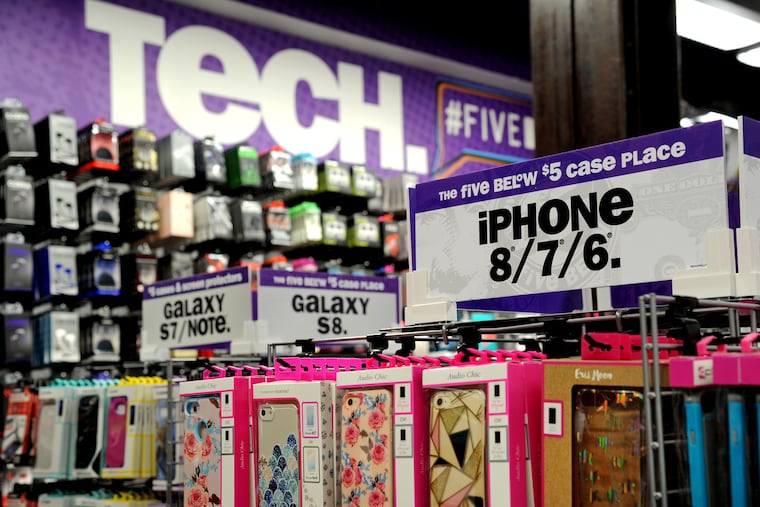Five Below blames U.S.-China tariffs for possible price increases
The Philadelphia-based discount chain is considering price increases on $1 to $4 items, as well as increasing some $5 items to $5.25 or $5.55.

The discount retailer Five Below is where kids buy things they don’t need but surely want — unicorn-shaped ring holders, glitter cell phone cases, and a poop racing game with a fart button — for $5 or less.
Now Philadelphia-based Five Below, which boasts low prices in its name, is considering charging more money.
The chain’s products are exposed to the increasing tariffs on goods imported from China and executives told analysts Wednesday they are considering price increases on $1 to $4 items, as well as increasing some $5 items to $5.25 or $5.55.
Five Below will test these higher prices in some locations with the expectation that they would roll out across the company’s 789 stores before the end of the summer.
Last month, President Donald Trump raised tariffs from 10 percent to 25 percent on $200 billion of Chinese goods and tweeted his intention to levy a greater tax on the remaining imported goods from China. That remaining $300 billion category of products includes clothes and toys.
Five Below imports about 70 percent of its products from China, Telsey Advisory Group analysts wrote in a June 6 note to investors, and the company is now paying the higher 25 percent tariff on about 15 percent of its total items.
“We understand the rationale for raising prices, but the strong value proposition must remain clear to customers for it to work and not alter the relevance of the concept," Telsey Advisory Group wrote in the note.
Separately, Five Below has been rolling out a concept called “Ten Below,” or “Just Wow,” where everything costs $10 and below.
The company already opened six of its Ten Below concepts last year to offer more items in the tech and room categories and plans to expand it to 25 stores by the end of the second quarter this summer, Five Below president and CEO Joel Anderson told analysts on the Wednesday first-quarter earnings call.
While Wall Street analysts think the $10-or-less section could be successful, they also point out the obvious contradiction with the chain’s name. Goldman Sachs wrote a note to investors in March saying a potential risk of higher prices could be “a brand identity crisis.”
Anderson did not share details on the performance of the $10-and-below items, other than to tell analysts “the feedback from our customers continues to be positive."
And as far as increasing prices beyond $5, Anderson said it is “a decision we do not take lightly. We have put a lot of thought behind this decision and we’ll proceed with pace and diligence.”
As more and more shopping happens online, legacy department stores, mass merchants, and new brick-and-mortar stores are looking to provide customers an experience. Five Below’s business strategy has been to encourage shoppers to “let go & have fun!”
This approach, along with staying on top of trendy toys like the fidget spinner craze in 2017, has led to sustained growth even as many other retailers are struggling. The company opened its first store in 2002 and has since expanded to more than 30 states. Net sales increased more than 20 percent last year to nearly $1.6 billion.
Though shares are down 17 percent — from $147.50 at the end of April to $123.05 Wednesday — analysts remain impressed with the business. Shares are up more than 20 percent compared with this time last year.
“FIVE remains a bastion of growth in a mature retail landscape,” Evercore ISI analysts wrote in a June 6 note to investors.
The company opened a net 125 new stores last year and 103 the year before, and executives remain confident in the chain’s ability to expand.
Five Below plans to open 145 to 150 stores in 2019, ending the year with 895 to 900 stores, mostly in existing markets, the company’s chief financial officer and treasurer, Ken Bull, told analysts on the earnings call Wednesday.
CEO Anderson called the new stores “the biggest driver of our growth.”
The company’s net sales grew 23 percent to $365 million in the first quarter ended May 4, with sales at existing stores increasing 3.1 percent compared with last year.